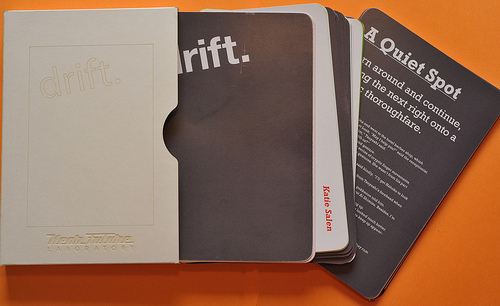 [Image: From the Drift Deck by Julian Bleecker and Dawn Lozzi].
[Image: From the Drift Deck by Julian Bleecker and Dawn Lozzi].
The Drift Deck, produced in 2008 by Julian Bleecker and Dawn Lozzi, is “an algorithmic puzzle game used to navigate city streets,” offering “instructions that guide you as you drift about the city.”
Each card contains an object or situation, followed by a simple action. For example, a situation might be—you see a fire hydrant, or you come across a pigeon lady. The action is meant to be performed when the object is seen, or when you come across the described situation. For example—take a photograph, or make the next right turn.
The deck has a tendency to sound a bit like a human behavior manual for urban residents suffering from Asperger Syndrome—”Uh Oh…” one card reads, “An awkward moment. Pause and take a photograph,” as if talking to Rain Man, or “Ugliness,” another card says, “Avoid it noticeably, gesturing and registering disgust,” as if the city would be more interesting if only we could be as flamboyant as RuPaul—rather than serving as a genuinely diagonal guide to the city.
But I love the Drift Deck‘s premise, combining as it does the Oblique Strategies of Brian Eno with the chance operations of John Cage, by way of Situationism and perhaps even the “let the dice decide” tactics of Luke Rhinehart.
 [Image: From the Drift Deck by Julian Bleecker and Dawn Lozzi].
[Image: From the Drift Deck by Julian Bleecker and Dawn Lozzi].
A non-sentimental Drift Deck, intended not as a way to emotionally enrich the urban experience but simply to densify the number of personal actions taken during a given span of time, would be an interesting thing to develop and explore. Basic, analog instructions (turn left, enter that shop, buy something, slow down) would, in the end, I’d suggest, generate at least as many random encounters.
This could also quite easily be turned into a mobile app: tap the screen at every intersection (or every hour on the hour) and random navigational options are generated. Combine this with Foursquare (“the mayor of turning-left at 44th Street”), Twitter, etc., and you could leave automatically generated traces of unique drifted paths for others to see. Repeatable experiments of random acts through the city.
There’s still the key question, though, of how to realize this without falling back onto a kind of Instabuddhism™, exhorting participants to appreciate their everyday lives with greater intensity. After all, the results could just as easily be disorienting and sharply alien—deliberately so—not instilled with a New Age sense of rejuvenated authenticity. Perhaps petty crimes could even be thrown in for good measure…
